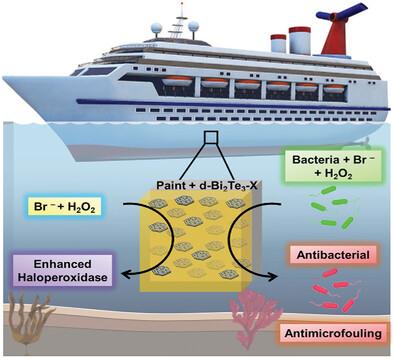Our official English website, www.x-mol.net, welcomes your feedback! (Note: you will need to create a separate account there.)
Defect Engineered Bi2Te3 Nanosheets with Enhanced Haloperoxidase Activity for Marine Antibiofouling
Small ( IF 13.0 ) Pub Date : 2024-06-27 , DOI: 10.1002/smll.202401929 Sagar Sunil Kulkarni, Dang Khoa Tong, Chien‐Ting Wu, Cheng‐Yen Kao, Surojit Chattopadhyay
Small ( IF 13.0 ) Pub Date : 2024-06-27 , DOI: 10.1002/smll.202401929 Sagar Sunil Kulkarni, Dang Khoa Tong, Chien‐Ting Wu, Cheng‐Yen Kao, Surojit Chattopadhyay

|
Defective bismuth telluride (Bi2 Te3 ) nanosheets, an artificial nanozyme mimicking haloperoxidase activity (hPOD), show promise as eco‐friendly, bactericidal, and antimicrofouling materials by enhancing cytotoxic hypohalous acid production from halides and H2 O2 . Microscopic and spectroscopic characterization reveals that controlled NaOH (upto X = 250 µL) etching of the nearly inactive non‐transition metal chalcogenide Bi2 Te3 nanosheets creates controlled defects (d), such as Bi3+ species, in d‐Bi2 Te3 ‐X that induces enhanced hPOD activity. d‐Bi2 Te3 ‐250 exhibits approximately eight‐fold improved hPOD than the as‐grown Bi2 Te3 nanosheets. The antibacterial activity of d‐Bi2 Te3 ‐250 nanozymes, studied by bacterial viability, show 1, and 45% viability for Staphylococcus aureus and Pseudomonas aeruginosa , respectively, prevalent in marine environments. The hPOD mechanism is confirmed using scavengers, implicating HOBr and singlet oxygen for the effect. The antimicrofouling property of the d‐Bi2 Te3 ‐250 nanozyme has been studied on Pseudomonas aeruginosa biofilm in a lab setting by multiple assays, and also on titanium (Ti) plates coated with the nanozyme mixed commercial paint, exposed to seawater in a real setting. All studies, including direct microscopic evidence, exhibit inhibition of microfouling, up to ≈73%, in the presence of nanozymes. This approach showcases that defect engineering can induce antibacterial, and antimicrofouling activity in non‐transition metal chalcogenides, offering an inexpensive alternative to noble metals.
中文翻译:

具有增强卤过氧化物酶活性的缺陷工程 Bi2Te3 纳米片用于海洋抗污损
有缺陷的碲化铋 (Bi2Te3) 纳米片是一种模仿卤过氧化物酶活性 (hPOD) 的人造纳米酶,通过增强卤化物和 H2O2 产生细胞毒性次卤酸,有望成为环保、杀菌和防微污材料。显微镜和光谱表征表明,对几乎不活泼的非过渡金属硫属化物 Bi2Te3 纳米片进行受控 NaOH(最高 X = 250 µL)蚀刻会在 d-Bi2Te3-X 中产生受控缺陷 (d),例如 Bi3+ 物质,从而诱导增强的 hPOD活动。 d-Bi2Te3-250 的 hPOD 比生长的 Bi2Te3 纳米片提高了大约八倍。通过细菌活力研究,d-Bi2Te3-250 纳米酶的抗菌活性显示,对海洋环境中普遍存在的金黄色葡萄球菌和铜绿假单胞菌的活力分别为 1% 和 45%。 hPOD 机制通过清除剂得到证实,表明 HOBr 和单线态氧具有该作用。 d-Bi2Te3-250 纳米酶的抗微污性能已在实验室环境中的铜绿假单胞菌生物膜上通过多种测定进行了研究,并且还在涂有纳米酶混合商业涂料并在真实环境中暴露于海水的钛 (Ti) 板上进行了研究。所有研究,包括直接的微观证据,都表明在纳米酶存在的情况下,微污垢的抑制率高达约 73%。这种方法表明,缺陷工程可以在非过渡金属硫属化物中诱导抗菌和抗微污垢活性,为贵金属提供廉价的替代品。
更新日期:2024-06-27
中文翻译:

具有增强卤过氧化物酶活性的缺陷工程 Bi2Te3 纳米片用于海洋抗污损
有缺陷的碲化铋 (Bi2Te3) 纳米片是一种模仿卤过氧化物酶活性 (hPOD) 的人造纳米酶,通过增强卤化物和 H2O2 产生细胞毒性次卤酸,有望成为环保、杀菌和防微污材料。显微镜和光谱表征表明,对几乎不活泼的非过渡金属硫属化物 Bi2Te3 纳米片进行受控 NaOH(最高 X = 250 µL)蚀刻会在 d-Bi2Te3-X 中产生受控缺陷 (d),例如 Bi3+ 物质,从而诱导增强的 hPOD活动。 d-Bi2Te3-250 的 hPOD 比生长的 Bi2Te3 纳米片提高了大约八倍。通过细菌活力研究,d-Bi2Te3-250 纳米酶的抗菌活性显示,对海洋环境中普遍存在的金黄色葡萄球菌和铜绿假单胞菌的活力分别为 1% 和 45%。 hPOD 机制通过清除剂得到证实,表明 HOBr 和单线态氧具有该作用。 d-Bi2Te3-250 纳米酶的抗微污性能已在实验室环境中的铜绿假单胞菌生物膜上通过多种测定进行了研究,并且还在涂有纳米酶混合商业涂料并在真实环境中暴露于海水的钛 (Ti) 板上进行了研究。所有研究,包括直接的微观证据,都表明在纳米酶存在的情况下,微污垢的抑制率高达约 73%。这种方法表明,缺陷工程可以在非过渡金属硫属化物中诱导抗菌和抗微污垢活性,为贵金属提供廉价的替代品。






































 京公网安备 11010802027423号
京公网安备 11010802027423号